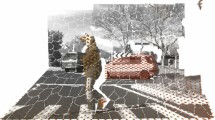Abstract
This paper proposes a new method for optical-flow and stereo estimation based on the inclusion of both spatial and temporal constraints in a variational framework. These constraints bound the solution based on a priori information, or in other words, based on what is known of a possible solution or how it is expected to change temporally. This knowledge can be something that (a) is known since the geometrical properties of the scene are known or (b) is deduced by a higher-level algorithm capable of inferring this information. In the latter case, the constraint terms enable the exchange of information between high- and low-level vision systems: the high-level system makes a hypothesis of a possible scene setup which is then tested by the low-level one, recurrently. Since high-level vision systems incorporate knowledge of the world that surrounds us, this kind of hypothesis testing loop between the high- and low-level vision systems should converge to a more coherent solution.
Similar content being viewed by others
References
Hirschmuller, H., Scharstein, D.: Evaluation of cost functions for stereo matching. In: CVPR07, pp. 1–8 (2007)
Baker, S., Scharstein, D., Lewis, J.P., Roth, S., Black, M.J., Szeliski, R.: A database and evaluation methodology for optical flow. In: Computer vision, 2007. ICCV 2007. IEEE 11th International Conference, pp. 1–8 (2007)
Ralli, J., Díaz, J., Ros, E.: Disparity disambiguation by fusion of signal- and symbolic-level information. Mach. Vis. Appl., pp. 1–13 (2010). doi:10.1007/s00138-010-0266-z
Krüger, N.: Three dilemmas of signal- and symbol-based representations in computer vision. In: Proceedings of the Workshop Brain, Vision and Artificial Intelligence, vol. 3704, pp. 167–176 (2005)
Kalkan, S., Yan, S., Krüger, V., Wörgötter, F., Krüger, N.: A signal-symbol loop mechanism for enhanced edge extraction. In: International Conference on Computer Vision Theory and Applications VISAPP’08, pp. 214–221 (2008)
Black, M., Anandan, P.: Robust dynamic motion estimation over time. In: Proceedings of Computer Vision and Pattern Recognition, pp. 296–302 (1991)
Black, M.: Recursive non-linear estimation of discontinuous flow fields. In: In Third European Conference on Computer Vision, pp. 138–145. Springer, Berlin (1994)
Werlberger, M., Trobin, W., Pock, T., Wedel, A., Cremers, D., Bischof, H.: Anisotropic huber-l1 optical flow. In: Proceedings of the British Machine Vision Conference (BMVC) (2009)
Weickert J., Schnörr C.: Variational optic flow computation with a spatio-temporal smoothness constraint. JMIV 14(3), 245–255 (2001)
Salgado, A., Sánchez, J.: Temporal constraints in large optical flow estimation. In: EUROCAST, pp. 709–716 (2007)
Bruhn A., Weickert J., Feddern C., Kohlberger T., Schnorr C.: Variational optical flow computation in real time. IEEE Trans. Image Process. 14(5), 608–615 (2005)
Alvarez L., Weickert J., Sánchez J.: Reliable estimation of dense optical flow fields with large displacements. Int. J. Comput. Vis. 39(1), 41–56 (2000)
Weickert J., Schnörr C.: A theoretical framework for convex regularizers in pde-based computation of image motion. Int. J. Comput. Vis. 45(3), 245–264 (2001)
Brox, T., Bruhn, A., Papenberg, N., Weickert, J.: High accuracy optical flow estimation based on a theory for warping. In: ECCV04, pp. 25–36 (2004)
Bruhn, A.: Variational optic flow computation: accurate modelling and efficient numerics. PhD thesis, Saarland University, Saarbrücken, Germany (2006)
Ralli, J., Díaz, J., Ros, E.: Complementary image representation spaces in variational disparity calculation. EURASIP J. Adv. Signal Process. (2011, in press)
Nagel H.H., Enkelmann W.: An investigation of smoothness constraints for the estimation of displacement vector fields from image sequences. PAMI 8(5), 565–593 (1986)
Brox, T.: From pixels to regions: partial differential equations in image analysis. PhD thesis, Saarland University, Saarbrücken, Germany (2005)
Zimmer, H., Bruhn, A., Weickert, J., Valgaerts, L., Salgado, A., Rosenhahn, B., Seidel, H.P.: Complementary optic flow. In: EMMCVPR, Lecture Notes in Computer Science, vol. 5681, pp. 207–220 (2009)
Acar, R., Vogel, C.R.: Analysis of bounded variation penalty methods for ill-posed problems. In: Inverse Problems, pp. 1217–1229 (1994)
Alvarez, L., Escalarín, J., Lefébure, M., Sánchez, J.: A pde model for computing the optical flow. In: CEDYA XVI, Universidad de Las Palmas de Gran Canaria, pp. 1349–1356 (1999)
Perona P., Malik J.: Scale-space and edge detection using anisotropic diffusion. IEEE Trans. Pattern Anal. Mach. Intell. 12, 629–639 (1990)
Ralli, J., Díaz, J., Ros, E., Ilonen, J., Kyrki, V.: External constraints in variational disparity calculation: hypothesis-forming-validation-loops and segmentation. Mach. Vis. Appl. (2011, in press)
Faugeras, O.D.: What can be seen in three dimensions with an uncalibrated stereo rig. In: ECCV ’92: Proceedings of the Second European Conference on Computer Vision, pp. 563–578 (1992)
Hartley, R.I.: Estimation of relative camera positions for uncalibrated cameras. In: ECCV ’92: Proceedings of the Second European Conference on Computer Vision, pp. 579–587 (1992)
Wedel, A., Pock, T., Braun, J., Franke, U., Cremers, D.: Duality tv-l1 flow with fundamental matrix prior. In: IVCNZ08, pp. 1–6 (2008)
Valgaerts, L., Bruhn, A., Weickert, J.: A variational model for the joint recovery of the fundamental matrix and the optical flow. In: Proceedings of the 30th DAGM symposium on Pattern Recognition, pp. 314–324 (2008)
Blake A., Zisserman A.: Visual Reconstruction. The MIT Press, Cambridge (1987)
Bruhn A., Weickert J., Kohlberger T., Schnörr C.: A multigrid platform for real-time motion computation with discontinuity-preserving variational methods. Int. J. Comput. Vis. 70(3), 257–277 (2003)
Trottenberg U., Oosterlee C., Schüller A.: Multigrid. Academic Press, San Diego (2001)
Barron J.L., Fleet D.J., Beauchemin S.S.: Performance of optical flow techniques. Int. J. Comput. Vis. 12, 43–77 (1994)
Fischler M.A., Bolles R.C.: Random sample consensus: a paradigm for model fitting with applications to image analysis and automated cartography. Commun. ACM 24(6), 381–395 (1981)
Author information
Authors and Affiliations
Corresponding author
Rights and permissions
About this article
Cite this article
Ralli, J., Díaz, J. & Ros, E. Spatial and temporal constraints in variational correspondence methods. Machine Vision and Applications 24, 275–287 (2013). https://doi.org/10.1007/s00138-011-0360-x
Received:
Revised:
Accepted:
Published:
Issue Date:
DOI: https://doi.org/10.1007/s00138-011-0360-x




